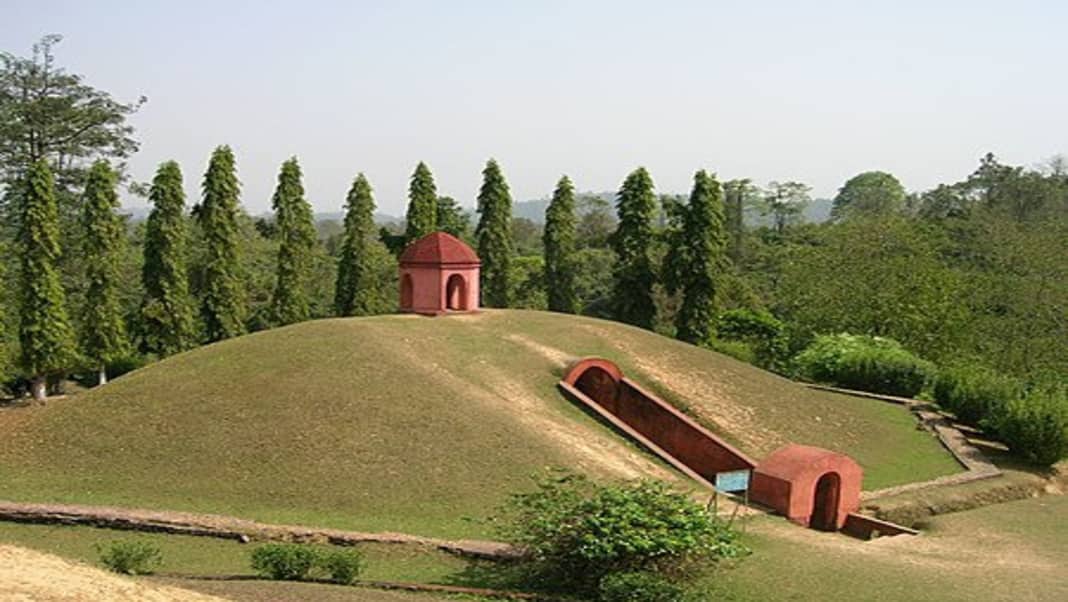Guwahati, July 19: Assam is on the brink of adding another jewel to its crown of World Heritage Sites.
Currently, Kaziranga and Manas National Parks hold this prestigious status, but soon they might be joined by the Mound-Burial System of the Ahom Dynasty.
The World Heritage Committee in its draft decision has inscribed Moidams – the Mound-Burial System of the Ahom Dynasty, India, on the World Heritage List as a cultural property.
The decision which is a mere formality now will be announced at the 46th session of the World Heritage Committee, scheduled to take place in New Delhi on July 21-31. India, for the first time, is hosting UNESCO’s 46th Session of the World Heritage Committee in New Delhi from July 21 to 31.

The Indian government had nominated it as a cultural property as the property is a royal sacred mound burial landscape of the Tai-Ahoms that practised this funerary tradition from the 13th to 19th centuries, has the highest concentration and best-preserved examples of Tai-Ahom moidams in the Brahmaputra Valley, and has the complete architectural, landscaping, and spiritual expression of the Tai-Ahom belief system, and demonstrates the evolution of moidam architecture.
An ICOMOS technical evaluation mission visited the nominated property from 5 to 11 October 2023. A letter was sent to the State Party on October 4 2023 requesting further information about the cultural landscape. Additional information was received from the State Party on February 19 2024. The nominated property has an area of 95.02 hectares and a buffer zone of 754.511 hectares.

WHAT ARE MOIDAMS: Moidams – the Mound-Burial System of the Ahom Dynasty are a sacred landscape in eastern Assam, with more than ninety burial mounds established by the Tai-Ahom over 600 years ago. The moidams of Charaideo contain the remains of the Tai-Ahom kings. They are set within a sculpted landscape that reflects Tai cosmologies, modifying the natural features of hills, forests, and water to create a sacred geography. Ninety moidams are found within the Charaideo necropolis, situated on elevated land.
“The nominated property is well-maintained, and there are no adverse effects of development. The moidams are mostly undisturbed” ICOMOS says in its evaluation report.
“The archaeological remains of the moidams are evidence of the architecture, layout, and manifestations of the Tai-Ahom beliefs and traditions. The continuing ritual practices of Tai-Ahom at the property are also significant to this criterion. The property demonstrates 600 years of Tai-Ahom traditions at Charaideo. It considers that the nominated property is an exceptional example of a Tai-Ahom necropolis that represents tangibly their funerary traditions and associated cosmologies” ICOMOS says in its report.

No settlements, modern high-rises, electricity infrastructure, industries, or agriculture are within the nominated property. There is minimal threat of development or encroachment, and the nominated property is well protected. The visual integrity is well established. While moidams are found in other areas within the Brahmaputra Valley, this particular cluster is regarded to be the most significant, and the continuing rituals in this landscape enhance its overall significance.
” The existing national and state protection laws are robust. No development is allowed to take place within the nominated property. A prohibited area of 100 metres surrounds the nominated property, and a regulated area of 200 metres surrounds the prohibited area” ICOMOS says.
ICOMOS considers that the nominated property demonstrates 600 years of Tai-Ahom traditions at Charaideo. It believes that the nominated property is an exceptional example of a Tai-Ahom necropolis that represents tangibly their funerary traditions and associated cosmologies.
The agency says the Mound-Burial System of the Ahom Dynasty are an outstanding example of a Tai-Ahom necropolis that represents tangibly the Tai-Ahom funerary traditions and associated cosmologies. For over 600 years, the Tai-Ahom sculpted this landscape according to their cosmological beliefs. The undulating topography was accentuated by excavating ditches and marking the troughs with moidams. “The natural vegetation was enhanced by planting sacred trees, and water bodies were added by channelising streams to fill them. Together these features symbolise the Tai universe, and a heaven-earth continuum” it says.
Also Read: Blocked drain leads to waterlogging in Dibrugarh town
Watch
Find latest news from every corner of Northeast India at hubnetwork.in, your online source for breaking news, video coverage.
Also, Follow us on-
Twitter-twitter.com/nemediahub
Youtube channel- www.youtube.com/@NortheastMediaHub2020
Instagram- www.instagram.com/ne_media_hub





